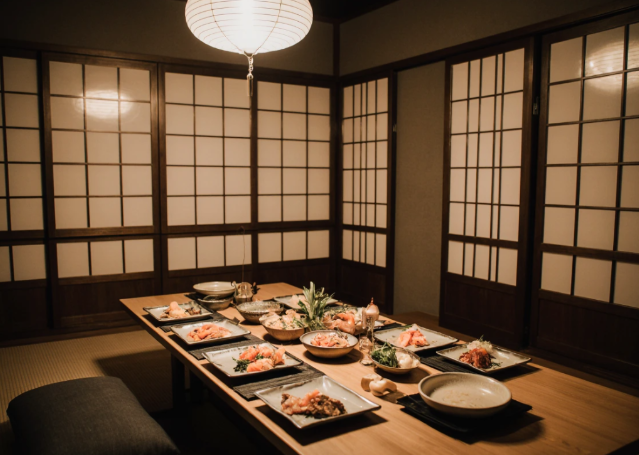Pontocho restaurants line a narrow alley in Kyoto running from Shijo-dori to Sanjo-dori, offering everything from affordable yakitori to exclusive kaiseki establishments. This 500-meter stretch along the Kamogawa River houses over 100 dining venues where Pontocho restaurants serve meals ranging from ¥500 per dish to ¥20,000+ multi-course experiences.
More about Pontocho:
- Pontocho Park Guided Tours
- The Complete Guide to Pontocho: Kyoto’s Most Atmospheric Alley
- Pontocho Yakitori: An Insider’s Guide to Kyoto’s Grilled Chicken Alley
- Traditional Kaiseki Pontocho: Your Expert Guide to Authentic Kyoto Dining
- Sushi in Pontocho: Traditional Edomae to Modern Fusion
How a Riverbank Project Created Kyoto’s Premier Dining District
Pontocho was established in 1670 when the Edo government conducted riverbank reinforcement work on the Kamogawa River, creating new land through reclamation. What began as a sandbar evolved into an entertainment hub where teahouses and inns quickly sprouted. In 1712, teahouses received official permission to employ “chatachionna” (tea-preparing women), marking the district’s shift into a pleasure quarter.
The area is traditionally considered the birthplace of Kabuki, Japan’s highly stylized theatrical art form. The Kamogawa Odori dance performance, established in 1872 as an attraction for the Kyoto Exhibition, played a crucial role in spreading Pontocho’s fame nationally. This event continues today at the Pontocho Kaburenjo Theater. The theater was completed in 1927 and was considered “modern architecture with a taste of the orient”.
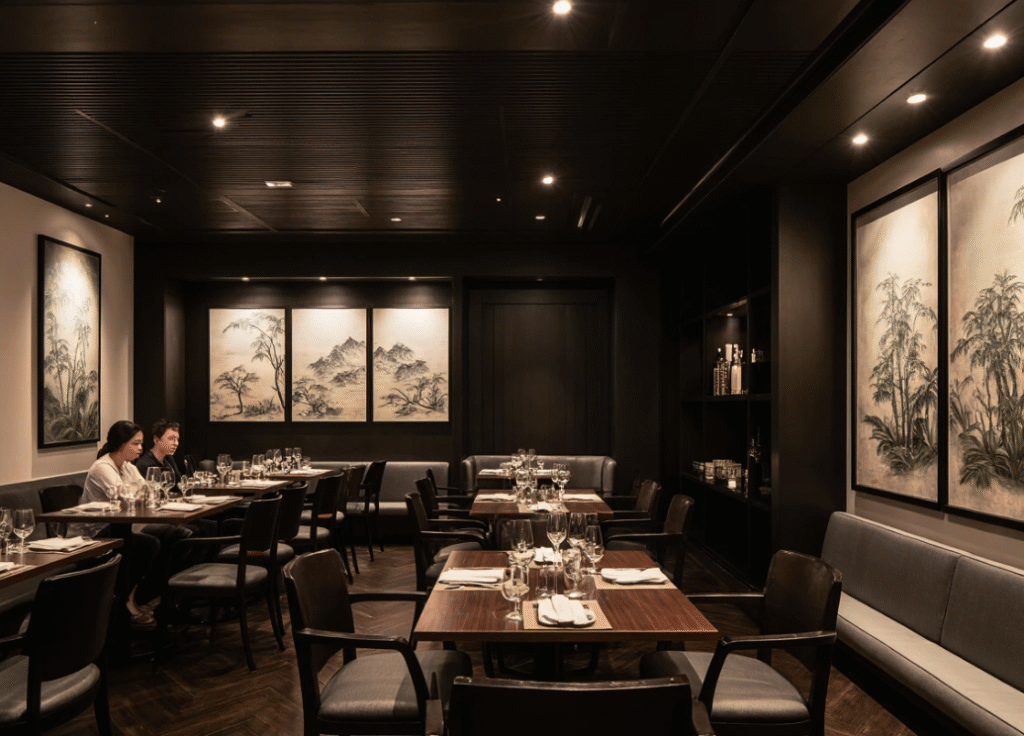
The district could have evolved differently. Without the 1872 dance performances, Pontocho might have remained simply another entertainment quarter rather than becoming synonymous with refined Kyoto culture. Or if stricter regulations had been imposed on teahouse operations, the area might have developed into a more commercial, less intimate dining destination. Instead, the balance between accessibility and exclusivity shaped Pontocho into the dining landmark it is today, where traditional wooden machiya buildings house everything from casual izakayas to invitation-only establishments.
For modern diners, this history matters practically. You’re eating in spaces that have served guests for over 350 years, where every restaurant benefits from centuries of culinary refinement and hospitality traditions. The narrow “eel bed” building design—shops in front, living quarters in back—creates an intimacy you won’t find in modern restaurant districts.
What Makes Pontocho Restaurants Different From Other Kyoto Dining Areas?
Pontocho restaurants specialize in traditional Kyoto cuisine that emphasizes seasonal ingredients, delicate flavors, and presentation. Dining options range from inexpensive yakitori to kaiseki restaurants and highly exclusive establishments. The district’s Pontocho restaurants offer sushi, tempura, sukiyaki, and shabu-shabu across all price points.
Think of Pontocho’s layout like airport security checkpoints. The narrow alley forces a natural flow, preventing the crowding and chaos you’ll find in wider districts like Nishiki Market. You move at a deliberate pace, notice individual restaurants, and make more considered dining choices rather than being overwhelmed by options.
From May to September, many restaurants along the eastern side construct temporary platforms called yuka or kawayuka over the Kamogawa River, allowing guests to dine outdoors while enjoying the river breeze. Some establishments extend this tradition until late September or early October, creating one of Kyoto’s most sought-after dining experiences.
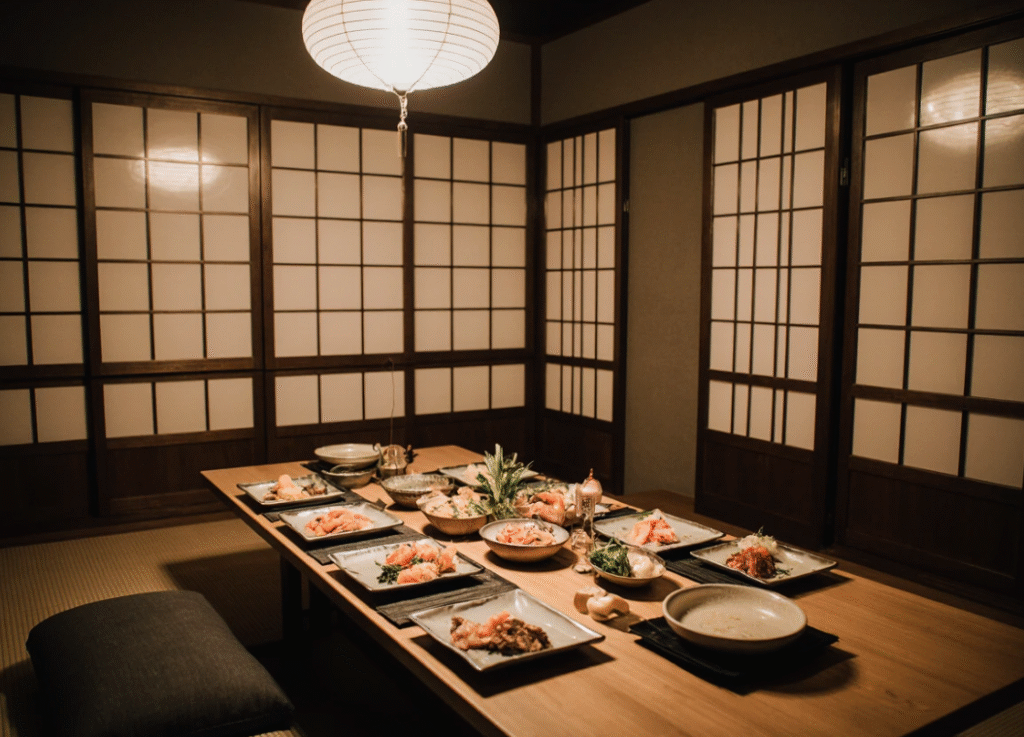
The riverside platform system operates differently than you might expect. Some restaurants charge seat fees of 500-1,100 yen per person specifically for kawayuka seating. During peak summer months (June through August), many establishments only offer evening service on these platforms due to food safety concerns about daytime heat. In May and September, you can often secure daytime slots at lower prices.
Here’s what tourists frequently misunderstand: they assume all riverside restaurants automatically have platforms. Only about 100 establishments in the Shijo-to-Sanjo section offer kawayuka. These platforms run from Gojo Street to Nijo Street, divided into four areas: Kamikiyamachi (Nijo to Sanjo), Pontocho proper (Sanjo to Shijo), Saiseki (Shijo to Donguri Bridge), and Shimokiyamachi (Donguri Bridge to Gojo). If riverside dining matters to you, confirm platform availability when booking, or you’ll arrive expecting a river view and find yourself in an interior seat.
“Many first-time visitors book any Pontocho restaurant assuming they’ll get riverside seating. The platforms are limited, and even restaurants with river views don’t all install them. Always ask explicitly: ‘Does this reservation include kawayuka seating?’ before confirming. The Japanese phrase is ‘Kawayuka no seki desu ka?'”
Pontocho Cuisine Types: What to Expect
Pontocho’s dining scene is renowned for kaiseki, a multi-course meal showcasing seasonality in Japanese culinary traditions. But the district extends far beyond this single style.
Traditional Kyoto Specialties:
- Kaiseki (multi-course traditional meals)
- Yuba (tofu skin)
- Obanzai (Kyoto-style home cooking)
- Hamo (pike conger eel, a Kyoto summer specialty)
- Kyo-yasai (Kyoto vegetables)
Grilled and Comfort Foods:
- Yakiniku (Japanese barbecue featuring wagyu beef)
- Yakitori (grilled chicken skewers)
- Teppanyaki (foods cooked on iron gridplates)
International with Kyoto Influence:
- Kyo-French (French techniques using Kyoto ingredients)
- Italian cuisine featuring seasonal Japanese produce
The area offers diverse options from sizzling steaks to delicate shabu-shabu, with something to suit every palate and budget. According to the official Japan National Tourism Organization, despite being a geisha district, there are many accessible and reasonably priced restaurants that can welcome foreign guests in English and other languages.
Where to Eat in Pontocho Based on Your Budget
Understanding price ranges helps set realistic expectations for your Pontocho experience.
| Budget Category | Price Range (Dinner) | Restaurant Types | What to Expect |
| Budget-Friendly | ¥2,000-4,000 ($13-27) | Casual izakayas, yakitori stands, a-la-carte restaurants | Multiple dishes at ¥500 each, including fresh seafood, vegetables, and meat options |
| Mid-Range | ¥5,000-10,000 ($33-67) | Established sushi restaurants, yakiniku spots, obanzai venues | Course meals with 5-7 items, quality ingredients, riverside seating options |
| Premium | ¥10,000-20,000+ ($67-133+) | Kappo restaurants with beautifully presented courses, high-end kaiseki | Multi-course kaiseki meals, premium wagyu, seasonal specialties |
During daytime kawayuka season (May and September), many high-end establishments offer lunch courses for ¥3,000-5,000, while evening meals at the same restaurants range from ¥5,000-8,000. The cost difference between lunch and dinner at the same restaurant can represent 40-50% savings.
Best Restaurants in Pontocho Alley
For Premium Wagyu Beef
Hiro is a yakiniku restaurant run by a famous Kyoto beef shop, serving high-quality wagyu beef with English-speaking staff available. The restaurant offers a standard set at approximately ¥5,000 including 6-7 different cuts for yakiniku, with kimchi, chawanmushi, beef sushi and rice.
Why this works: When a beef shop opens its own restaurant, you’re bypassing the middleman. They select cuts before other restaurants see them, meaning better marbling at lower prices than competitors.
Wagyu Ryoutei Bungo provides an intimate setting with meticulously prepared dishes where each wagyu cut is carefully selected, offering various preparations from steaks to shabu-shabu.
For Traditional Kyoto Cuisine
Kyomachiya Obanzai Kohaku, set in a beautifully preserved machiya townhouse, focuses on obanzai—home-cooked dishes passed down through generations. The restaurant highlights seasonal ingredients prepared to maintain their natural flavors, with small dishes allowing guests to sample a wide range of tastes.
Uryu Pontocho Hana serves authentic Kyoto cuisine with finely selected ingredients, specializing in hamo (pike conger) and pufferfish, where guests can enjoy kaiseki meals in elegant, historic dining spaces.
For Riverside Dining (Kawayuka)
Pontocho Izumoya features 100 riverside seats along the Kamo River from May 1st to October 31st, with their signature “Hyotan Bento” lunch (¥3,190-3,740) and dinner options including sukiyaki, shabu-shabu (from ¥3,960), and kaiseki courses (¥6,600-11,000).
Kushiemon occupies a prime second-floor location where guests can view the Kamogawa River while dining. The elevated position provides better river views than ground-level restaurants while maintaining the intimate Pontocho atmosphere.
Kyo-French Pontocho Kishimoto allows diners to savor French culinary skills infused with Kyoto’s flavors on traditional kawayuka platforms, with the chef incorporating seasonal Kyoto produce like hamo and Kamo eggplant into innovative dishes that marry French techniques with local taste traditions.
For Sushi
Kappa Sushi, located overlooking the Kamogawa River, offers Edo-style sushi and a-la-carte dishes, with lunch starting from ¥3,800 and dinner from ¥4,800, featuring a kaiseki course and seasonal kawayuka during summer months. The restaurant prides itself on using the freshest locally and seasonally sourced ingredients.
Yoshino Sushi stands among the highly regarded establishments in the alley, where skilled chefs prepare traditional Edomae-style sushi using premium seasonal catches.
For Unique Experiences
Kichi Kichi, run by chef Motokichi Yukimura, serves omurice (Japanese omelette over rice) with prices of ¥1,600 for small and ¥3,000 for regular sizes, alongside ox tongue stew at ¥3,800. The chef performs a theatrical cooking show, making this intimate 8-seat counter restaurant one of Kyoto’s most sought-after reservations.
The chef’s performance involves precise knife work that opens a perfectly cooked omelette to cascade over fried rice, accompanied by his signature sounds and movements. The demi-glace sauce complements fluffy fried rice with well-harmonized contrasting textures.
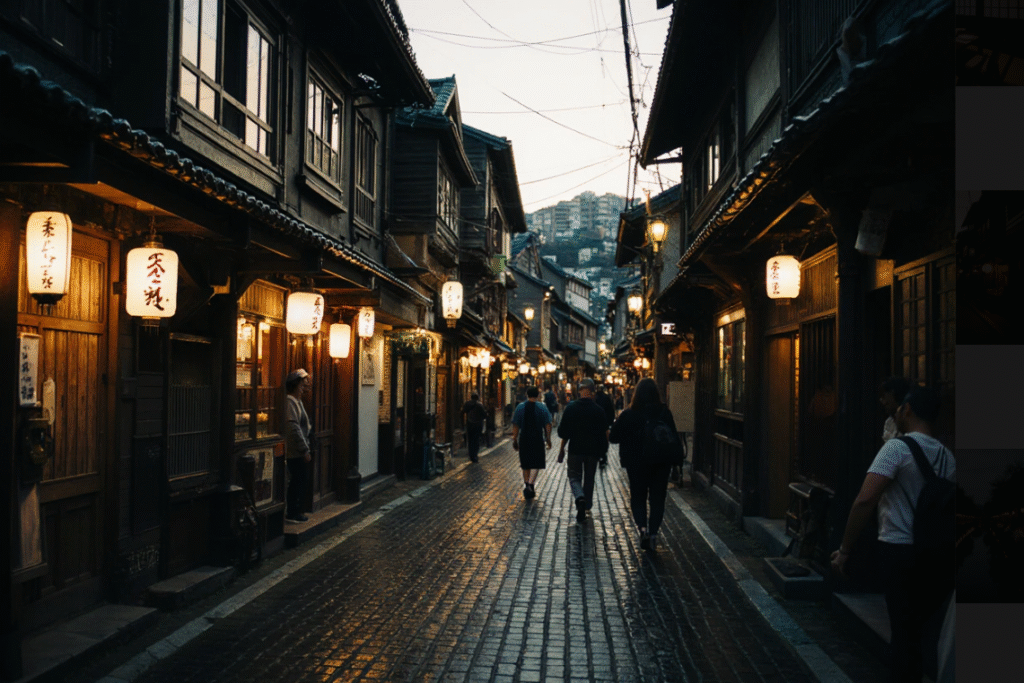
The booking challenge: Kichi Kichi changed its reservation system, ending advance reservations on January 7th and requiring customers to visit the restaurant directly for same-day reservations. Plan to arrive when the restaurant opens to secure one of the limited seats. Some third-party booking services charge ¥1,200 per person as a reservation fee separate from meal costs.
Ukiya Pontocho specializes in freshly hand-made soba noodles prepared each morning, with their signature Uki Soba served with whipped raw egg and natto, or Ukiten Soba with tempura.
Pontocho Best Cheap Eats
Yamatomi, an authentic Kyoto cuisine restaurant operating for over 50 years, offers 100 or more kinds of a-la-carte dishes for ¥500, with fresh ingredients including seafood, beef, vegetables, and sausages, welcoming walk-in tourists. Their specialties include tetsu-pin-age (spitted cutlet), yuba, tofu, namafu (raw wheat gluten), and oden.
Think of Yamatomi like a tapas bar where you build your meal piece by piece. At ¥500 per dish, three people ordering six dishes each pay roughly ¥9,000 total—the same as one person’s premium kaiseki meal. You sample more variety while keeping costs under control.
Three Common Mistakes That Waste Time and Money
Mistake 1: Assuming Walk-Ins Work at Pontocho Restaurants
Many tourists arrive at 7 PM on Friday hoping to snag a table at popular Pontocho restaurants. Do Pontocho restaurants require reservations? Yes, many establishments are small and exclusive with limited seating, making advance reservations advisable, especially for popular venues or during peak tourist seasons.
Here’s what happens: you spend 45 minutes walking the alley checking availability. Most places are fully booked. You settle for whatever accepts walk-ins, which often isn’t your first choice. That 45 minutes searching could have been spent actually eating if you’d booked ahead.

- Price of the mistake: Lost time (45-60 minutes of your evening), settling for second-choice restaurants, potential disappointment, and rushed dining at whatever’s available. Highly popular restaurants among locals like Yoshiya require reservations at least one month in advance.
- Real example: Sarah and Tom from Seattle visited Pontocho in May 2024. They wanted kaiseki with kawayuka seating but didn’t book ahead. After checking 12 restaurants over 50 minutes, they found an available izakaya table—indoors, no river view, and not their preferred cuisine. They spent ¥8,000 ($53) each on a meal they didn’t particularly want, while the kaiseki experience they’d researched cost ¥10,000 with advance booking. The real cost: wasted time, disappointment, and only saving ¥2,000 to eat food they didn’t choose.
- The solution: Book restaurants 2-4 weeks ahead for standard evenings, 1-2 months for weekends or kawayuka season. Your hotel concierge or ryokan staff can make reservations, navigating any Japanese-only systems.
Mistake 2: Booking Away From the River When Riverside Dining Matters
Tourists read that Pontocho has “river views” and assume any restaurant delivers this experience. Most restaurants along the eastern side of the alley overlook Kamogawa River, but only certain establishments build temporary platforms from May to September.
- Why people make it: Marketing photos show the kawayuka platforms extensively. Many assume this represents standard seating rather than seasonal, limited availability.
- Price of the mistake: Booking a restaurant expecting to dine over the river, then discovering your table is in an interior room with no river access. The disappointment compounds because riverside dining often represents a significant part of why you chose Pontocho over other Kyoto dining districts. You’ve paid similar prices for a fundamentally different experience.
- Real example: Michael booked what he thought was “riverside dining” in June 2024 at a restaurant with river views mentioned online. He paid ¥12,000 ($80) per person for kaiseki. Upon arrival, he learned his reservation was for an interior table—the kawayuka platforms were fully booked and required separate advance booking with a ¥800 seat charge. He watched other diners enjoy the outdoor experience he’d envisioned while eating the same food in a closed room. The same restaurant’s kawayuka slots were available three weeks earlier when he could have specified his preference. Total regret: paying premium prices without the premium experience that motivated the splurge.
- The solution: When booking any restaurant from May through September, explicitly confirm: “Is this reservation for kawayuka (riverside platform) seating?” Get written confirmation. Understand that these platforms may carry additional seat charges of ¥500-1,100 per person, but the experience justifies the premium.
Mistake 3: Choosing Kaiseki Without Understanding the Commitment
Kaiseki represents the pinnacle of Japanese dining. First-time visitors often book one because “everyone says you must try kaiseki in Kyoto.”
- Why this backfires: Kaiseki consists of multiple courses showcasing seasonal culinary traditions. These meals typically last 2-3 hours and involve 7-14 small courses. Each course requires attention, appreciation, and often explanation. If you’re not genuinely interested in this style of dining—if you prefer larger portions, faster meals, or more familiar flavors—kaiseki becomes an expensive obligation rather than a highlight.
- Price of the mistake: Spending ¥10,000-20,000 on a 2.5-hour meal you don’t fully enjoy because you’re hungry after small courses, bored by the pace, or uncomfortable with unfamiliar ingredients. That’s roughly $130 per person for an experience that doesn’t match your actual preferences.
- Real example: Jennifer and Mark from Austin booked a ¥15,000 ($100) per person kaiseki dinner in August 2024 based on guidebook recommendations. By course five of twelve, they were restless. Mark doesn’t eat raw fish and couldn’t consume three courses. Jennifer was still hungry after the meal and bought convenience store onigiri afterward for ¥600. They spent ¥30,600 total ($204) on an experience that left them unsatisfied, when a ¥6,000 yakiniku dinner with larger portions would have cost ¥12,000 total and matched their actual dining preferences—saving ¥18,600 ($124) while enjoying themselves more.
- The solution: Ask yourself honestly: “Do I want to spend 2-3 hours savoring small courses with unfamiliar ingredients?” If yes, kaiseki is perfect. If you’d rather have a substantial meal in 60-90 minutes, choose yakiniku, shabu-shabu, or a-la-carte izakaya dining. There’s no shame in preferring other styles—Pontocho offers excellent options across all categories.
Pontocho Food: A Balanced Perspective on What the District Gets Wrong
While Pontocho restaurants deserve their reputation, some aspects frustrate even seasoned visitors.
The reservation system is unnecessarily complex. Many Pontocho restaurants require phone reservations in Japanese only, don’t appear on international booking platforms, and some don’t have websites. While many establishments offer English menus, numerous restaurants still require introductions and advance reservations. This creates unnecessary barriers for international visitors willing to pay full prices and follow dining etiquette.
- Pricing lacks transparency. Unlike restaurants in many countries where you can check full menus online, Pontocho establishments often list “courses from ¥X” without detailed breakdowns. You don’t learn the final cost until you’re seated and ordering. While not deliberately deceptive, this opacity makes budgeting difficult for travelers.
- The narrow alley creates bottlenecks. On busy evenings, especially during cherry blossom and autumn foliage seasons, the single-lane alley becomes congested with tourists taking photos. What should be a 5-minute walk from Shijo to Sanjo can take 15 minutes when you’re navigating crowds.
- Quality varies dramatically. The same narrow alley contains both Michelin-starred establishments and mediocre restaurants trading on location alone. Without local knowledge or thorough research, you might randomly choose poorly and miss genuinely excellent options just doors away.
Who should skip Pontocho? If you prefer straightforward, efficient dining where you walk in, order quickly, eat, and leave within an hour, Pontocho’s more formal establishments will frustrate you. The district rewards those who embrace slower, more ceremonial dining. Additionally, solo travelers on tight budgets may find better value elsewhere—many Pontocho restaurants set minimum orders per person or require course meals that make solo dining expensive.

The upside: Pontocho’s complexity filters casual diners, maintaining the district’s refined atmosphere. Those who invest time in research and reservations get rewarded with experiences matching the effort.
Pontocho Reservations: Practical Information For First-Time Visitors
Getting There
Pontocho is accessible from Kawaramachi Station on the Hankyu Line and Sanjo Station on the Keihan Line, both a short walk from the alley. The closest bus stop is Shijo Kawaramachi, served by lines 4, 5, 17 and 205 from Kyoto Station.
From Kyoto Station, the bus takes approximately 15 minutes while train combinations require 10-15 minutes depending on connections. Walking from nearby hotels typically takes 10-20 minutes. You can find detailed access information on the official Kyoto tourism website.
When to Visit
Most restaurants open around 17:00 and operate until 23:00, though some also serve lunch. The alley comes alive after dark when lanterns illuminate the traditional architecture.
Seasonal considerations:
- May-September: Kawayuka season brings premium riverside dining but requires advance booking
- Spring (March-April): Cherry blossom crowds increase reservations difficulty
- Autumn (October-November): Peak foliage season creates similar demand
- Winter (December-February): Fewer crowds, easier walk-ins, but no riverside dining
What to Wear
Pontocho spans casual to exclusive establishments. Yakiniku restaurants and izakayas accept casual attire. Mid-range and premium kaiseki restaurants expect smart casual clothing—no shorts, tank tops, or athletic wear. High-end establishments offering geisha entertainment often require more formal dress codes.
Cultural Etiquette
When encountering geishas and maikos, refrain from taking photos without permission or impeding their movement. These professionals are traveling to appointments, not posing for tourists.
Many restaurants remove shoes at the entrance. Wearing clean, hole-free socks matters. Some establishments provide slippers, others expect you to walk in socks.
Tipping is not practiced in Japan. Your bill includes service, and attempting to tip may cause confusion or offense.
English-Friendly Restaurants Pontocho
Many establishments offer English menus, making the alley accessible to international visitors. However, complex kaiseki menus may only explain dishes in Japanese. Don’t hesitate to ask staff for explanations—most will patiently describe each course even if their English is limited.
At restaurants like Hiro, chefs and waiters can speak English, making communication easier for international guests.
Making Reservations
Your hotel or ryokan concierge provides the easiest reservation method. For exclusive experiences at high-end establishments with geisha entertainment, restaurants often require introductions and reservations well in advance.
Some restaurants accept international booking platforms like TableCheck or byFood. These services charge no extra fees for most restaurants and provide English interfaces.
For last-minute options, some izakayas like Ponto accept walk-ins and have staff accustomed to foreign customers, with meals costing ¥3,000-4,000 per person.
Surrounding Attractions
Pontocho’s central location makes it ideal for exploring nearby attractions. Gion, another famous geisha district, lies just across the Kamo River, while Nishiki Market is within walking distance. You can easily combine Pontocho dining with afternoon visits to these areas. For comprehensive guidance on exploring the district, check out InsideKyoto’s detailed Pontocho guide.
Pontocho Bar Street and Nightlife
The white plover (chidori) appearing on lanterns throughout Pontocho serves as the district’s official emblem. Red lanterns bearing this symbol illuminate the alley at night, creating the enchanting atmosphere. Locals use this symbol to distinguish authentic Pontocho establishments from nearby restaurants trying to capture spillover business.
Pontocho functions as one of Kyoto’s five geisha districts (hanamachi) where geishas have been entertaining patrons since the 16th century. The Pontocho Kaburenjo Theater hosts the annual Kamogawa Odori dance performances, which continues to be held currently with a number exceeding 184 performances, now boasting the greatest number among the five Kyoto Hanamachi districts. This charm has gained a good reputation overseas, attracting overseas celebrities such as Jean Cocteau and Charlie Chaplin.
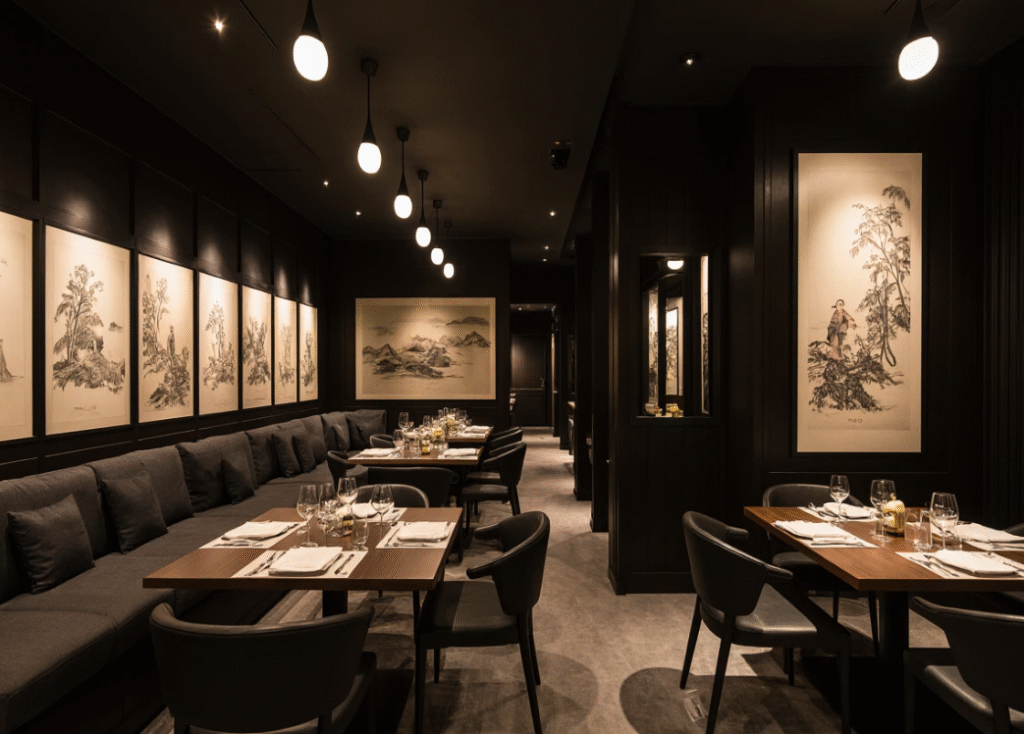
The name itself carries history, deriving from “ponte” (the Portuguese word for bridge) combined with “cho” (the Japanese word for town or street). This Portuguese influence reflects Kyoto’s historical international connections during the period when the district developed.
Since 2021, thousands of electric cables that were hanging above the passersby have been buried and their poles removed, with asphalt concrete replaced by more authentic-looking pavement as Kyoto municipality committed to preserving the old-fashioned charm of its most touristic historical districts.
“Don’t photograph your food throughout the meal at traditional restaurants. Take one establishing shot when the first course arrives if you must, then put your phone away. Constant photography disrupts the carefully paced kaiseki experience and shows disrespect to chefs who spent hours preparing your meal. Enjoy the moment—your memories will be richer than any Instagram post.”
Pontocho Dining Guide: Making Your Choice
After reading about dozens of options, you might feel overwhelmed. Here’s a simpler framework:
Choose kaiseki dining if you:
- Enjoy multi-course tasting menus at home
- Appreciate presentation and ceremony
- Have 2-3 hours for dinner
- Want to understand traditional Kyoto culture through food
Choose yakiniku or shabu-shabu if you:
- Prefer interactive, cook-it-yourself dining
- Travel with companions who enjoy shared experiences
- Want substantial portions
- Like controlling your meal’s pace
Choose izakaya or a-la-carte restaurants if you:
- Prefer casual atmosphere over formal dining
- Want to sample multiple small dishes
- Travel with varied dietary preferences in your group
- Operate on a tighter budget
Choose kawayuka (seasonal) if you:
- Visit between May and September
- Value setting as much as cuisine
- Can book well in advance
- Don’t mind paying premium prices for location
Pontocho Izakaya Recommendations and Budget Dining
Pontocho doesn’t demand perfection from visitors. The district welcomes those who approach it with genuine interest, whether that means splurging on once-in-a-lifetime kaiseki or enjoying ¥500 dishes at Yamatomi. Both represent authentic Pontocho experiences.
The narrow alley lit by lanterns, the sound of the Kamogawa River, the glimpse of a maiko hurrying to an appointment—these details enhance any meal into something memorable. Choose restaurants matching your preferences and budget, make reservations when required, and allow the district’s centuries-old atmosphere to work its magic.
Whether you’re searching for Pontocho Michelin-starred venues or exploring Pontocho alley food at casual eateries, this historic district delivers unforgettable culinary experiences that blend tradition with accessibility.
